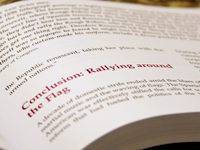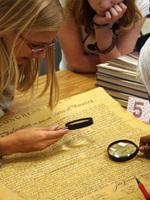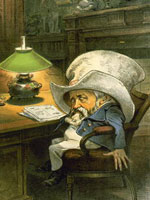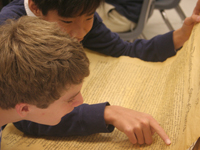John Bieter: So many of the grants, I think, separate content and pedagogy. So they do summer intensives that are loaded up with wonderful scholars that come in and do wonderful work, but if I'm a classroom teacher, 5th grade, 9th grade, or 11th grade, and I've got 20 minutes to cover this topic—four days is going to enrich me tremendously, but can I really distill that down to something my students could use? And can I—I would argue, most importantly, develop a set of skills that are going to be retained as long or, we hope, even longer than the information, that may or may not be relatively fleeting?
So what we really try to do consciously, and I think the biggest—Kathleen and I sat down after year one and said we really need to retool—is to develop content and pedagogy alongside of each other and to integrate that in everything that you do. So with all your partners, insist that they do that. With your scholars, get them to practice exactly this model that we've been trying to do.
Kathleen Budge: So one of the things that I think I have an advantage and a disadvantage. I'm not a historian, I'm not a history teacher, I'm an educator, actually an elementary teacher, before I went to higher ed. And so I have learned a tremendous amount in terms of what John and the other grant writers have been trying to get teachers to do that's different than just knowing content. And so the whole title, "Making the Invisible Visible," historians, obviously we all think in our head and it isn't a visible thing, and so one of the things we've tried to do in the grant is really focus in on helping teachers and kids literally see the thinking of historians.
And so when John says we ask the scholars to do this, too, when the scholars come who are experts in some period of history, we're also asking them to open their thinking to the teachers so they can see, when you look at a source, what are you, what are the questions. In reading, in the literacy field, it's called a think-aloud.
John Bieter: So there are three big things that we continue to talk about—the work of historians and the work of teachers. And we say that historians frame problems and they use evidence to generate accounts, so that's our simplified way, and in each one of those we take and we focus on one of those per year of our TAH grant. So framing a problem is critical. Knowledge gets created out of questions that arise, so if you don't have a good question or you don't have a good problem, you're not going to be interested in the class that I'm teaching. So it's critical that the problem be framed well and drive the instruction because than evidence can get gathered and accounts can get created.
On the teacher side of that, we're trying to say that instruction is critical to this whole process, that the way that the teachers generate assignments is formative to that, and then the third component of the rubrics is we're trying to say what happens with student work because ultimately it's got to end there. So our rubric tests those three dimensions that parallel for us framing problems, using evidence, and generating accounts, but what we realize is that there's really a dearth of well-generated tools to get at what we thought was really the essential part of it, which is the historical thinking skills.
Kathleen Budge: We would not have thought of creating what we created, nor the purposes for which we think, now, it's going to be able to be used. Originally the design was we knew we needed to measure historical thinking in teachers and in kids because it was part of the grant that we wrote, and so we knew we either had to find a tool or develop a tool to do that, to evaluate the entire project. And as it turns out it's written in such a way that we believe that it will have much more valuable, in my opinion, formative uses with teachers—because even as we showed it to them and got feedback and explained that this is really to evaluate the effectiveness of our grant project, what we found is organically, teachers starting to work together, to talk about, well, if I really am going to create a lesson plan or a unit, and this is the rubric for it, this is a three, this is a two, this is a one, what does that really look like?
And so they're starting to dig in deeper together, which was part of what we hoped to do, is that they would be a community of professionals that would work together. And the rubric's been a bit of a prompt to help them do that, even though it was designed for a different purpose. So now we see it as having these two purposes—the summative purpose and a formative purpose—that we hope, we think, has the potential to guide instruction.
John Bieter: There's an assumption that if I just pour enough information in at the top, it will funnel its way down into the classroom and this will work, and we're just not convinced that that is going to work and nor were we absolutely convinced that after year one it was working. And so what we really realized was that this rubric forces us to really recalibrate, redesign, the whole thing. You just simply can't, if you have to address these things, you can't think that way anymore.
And so it reorients, it reframes, the way we do our seminars ourselves, the way we do the coming year, and it forces us to redo it because we have to answer it and as professors, we can fall into that trap as much as anybody else. And it gives us a common way to move away from that tendency, and, I think, in many ways, that ease of just dealing on the content side. It's not to minimize content at all, but it's instead to say that content has far greater meaning when it's matched up with a set of skills that you're developing. The content sticks so much better if it's actually attached to a real problem that you're trying to solve.
John Bieter: So there's a show on television called Inside the Actor's Studio, if you're familiar with that [unintelligible], where professionals come and they interview them, and what they're really trying to do is get that professional to externalize the process that they just intuited. So, along with Bob Bain, we do a variation of it called "Inside the Historian's Study," and so it gives teachers a chance to ask questions, to ask how do you work, how do you do this? So that they hear teachers—they hear professors, rather, scholars in the field, say that this is how I go about it. And most of them have done it so many times, so it's just second nature to them. For them to externalize that process and really verbalize it so that teachers can be clear about it. Teachers sometimes, again, after teaching for so many years, they may kind of intuitively do it, but if they can make it even more clear for themselves and for their students, it seems to raise the whole level of what happens.
Part of our grant was to connect the local situation, local events, with the national narrative, and try to realize that place really matters, and that if students can connect those things, it's a lot richer environment for them. We're going to go down to the Basque Museum, the cultural center, Boise has a pretty sizable Basque community, an ethnic group in Spain and France that runs along the border there. And so we think that we're more sensitive to saying, okay, where could it fit, where does it fit in the curriculum, what's the problem that we're dealing with, and then, what's the sources that we could tag that could more accurately help them work with this problem—rather, with their students in their classroom at the 5th, 9th, and 11th.
So in that way, it feels like it's much more bottom up, it's much more consistent with this process that we've been talking about, and it's less just hoping that if you pour enough information in somehow it's going to stick, a couple topics that might help teachers out. We feel like it's just a much more natural way in the sense that that's really how historians work and ultimately we think that's how students learn, or learn more effectively, anyway.
Kathleen Budge: What we have found, in another lesson learned, is that it is very difficult for teachers to think of curriculum in terms of problems and problems spaces, or essential questions and enduring understandings—that's kind of Jay McTighe and Grant Wiggins's verbiage for it. That's kind of, that is, one marker of a higher quality of intellectual engagement that we would hope to see in instruction, in lesson planning, and finally, in student work, so when kids are engaged in problems and thinking about enduring understandings, that's a higher level of intellectual quality, and that's what we're looking for.
John Bieter: So I think the toughest thing is how you view yourself and some still view themselves as imparters of knowledge and not developers of a process, or at least along a—both of those things. So that the challenging thing is that this framework, this rubric, may immediately call into question how I view myself as a teacher. And so whenever identity gets threatened, you know you have a roadblock. There's some that just immediately take to it, and it gives language to what they know that they should be doing—or feel like they have been doing, many of them. There's some that are in the middle, and there's others are really hesitant to do it. I mean, we're really muddling our way through this, so if we seem quite polished, than we're clearly not, we're just working this the same way as I think any other group would.
Our teachers made a three-year commitment to the program, so you've got teachers who were pretty committed, if they're willing to give three years anyway. And the other thing is that, for substantive change to really occur, it takes that kind of time—because what we're seeing now is that at the end of this second year, it's beginning to permeate. And the ones that were already there are even more there and the ones, that critical middle group that you want to get on really—to make, to feel like the grant turn. Both of us at the end of this summer looked at each other and said, this second set of summer sessions, said, I think we turned a corner here, I think we got a critical mass believing what we're doing really makes sense. But this is two years of doing it.
Kathleen Budge: You have them long enough you develop trust. You make it safe for them to share, you give them lots of choice where they can volunteer and they can emerge as leaders, they can support each other. And I think we're seeing it, this is a really fine—one of the best parts of being involved in this TAH group is the teachers themselves, this is a fine group of teachers. They were strong teachers when they came in to begin with. But I think that we made some good decisions to have the same group over a course of years and to try to be as purposeful as we can about developing a safe environment where they can learn from each other.



